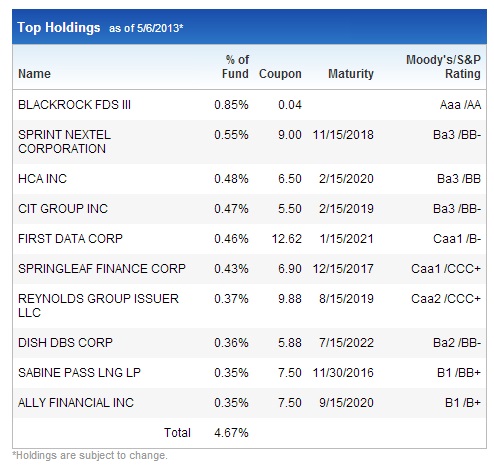
ETF Sage
Canadian ETF knowledgebase

ETF Sage
Canadian ETF knowledgebase
The iShares U.S. High Yield Bond (CAD Hedged) (XHY) seeks to provide income by replicating, to the extent possible, the performance of an index which is a diversified representation of the USD denominated high yield corporate bond market, net of expenses, and, to the extent possible, hedge any resulting U.S. dollar currency exposure to Canadian dollars.
Currently, XHY seeks to replicate the performance of the Markit iBoxx USD Liquid High Yield Index.
The Markit iBoxx USD Liquid High Yield Index consists of liquid USD high yield bonds, selected to provide a balanced representation of the broad USD high yield corporate bond universe.
The index is used as a basis for tradable products, including ETFs. Multi-contributor pricing and support for the index from leading financial institutions ensure that the index is a tradable reflection of the corporate high yield bond market.
The index is based on market-value weighting, with an individual constituent issuer cap of 3%.
| Fundamentals | |
|---|---|
| Category (main) | USA Fixed Income - Corporate (non-investment grade) |
Underlying Index  |
Markit iBoxx USD Liquid High Yield Index CAD hedged |
| ETF Structure | Passive type. Endeavours to return the Index return before fees/costs |
Asset Class  |
Fixed Income - Corporate (non-investment grade) |
Region  |
USA |
| Issuer | iShares Canada by Blackrock |
| ETF Home Page | Available here |
| Fund Facts | |
|---|---|
| Inception Date | 21 Jan 2010 |
Total Holdings  |
984 |
Distribution Frequency   |
Monthly |
Leverage  |
None |
Significant Currency Exposure 
|
Yes |
Currency Hedging 
|
Yes |
| Fees | |
|---|---|
Management Fee  |
0.60% |
Management Expense Ratio (MER)  |
0.67% |
| Trading Information | |
|---|---|
| Ticker | XHY |
Exchange  |
TSX (Toronto Stock Exchange) |
Currency  |
CAD |
| Eligibility | |
|---|---|
Eligibility *  |
RRSP, RRIF, RESP, TFSA, DPSP, RDSP |
DRIP available **  |
Yes |
PACC Plan available **  |
No |
SWP available **  |
No |
* Always check eligibility with your plan operator as plans and accounts can differ
** Not all brokers can facilitate these plans. Check with your broker.
To view the TSX or Morningstar fund page for this ETF click on the Fund Data menu tab or below:


Bonds/fixed income funds should be an important component in most investment portfolios. The general rule of thumb is that you should have the percentage equivalent in bonds as per your age. So if you are 30, your portfolio should comprise 30% bonds/fixed income funds.
However the bond markets are in near unprecedented territory. Years of central bank stimulus packages and ultra-low interest rates since 2008's Financial crisis have created a massive bubble.
Many analysts including Peter Boockvar, managing director and chief market analyst at The Lindsey Group, agree. He stated in July 2016 that the bond market is in an ‘epic bubble of colossal proportions’.
Until the buddle bursts, we cannot recommend buying bonds/fixed income funds.
If you absolutely have to buy bonds/fixed income funds then ensure you always check the Yield To Maturity (YTM), also known as the Weighted Average Yield To Maturity.
The YTM is much more important than the bond's current yield (also called the current distribution yield).
The YTM (unlike current yield) considers not only the coupon income, but any capital gain or loss that an investor will realize by holding the bonds to maturity. It also considers reinvestment of the coupons.
Unfortunately the frothy bond market has meant many fixed income ETFs have had to purchase many bonds at a premium. An ultra-low rate environment and purchasing bonds at a premium makes for a particularly terrible climate for income seekers, and new fixed income investors.
Protect yourself by understanding YTM and checking the YTM of any fixed income security you are considering purchasing. Also understand quality ratings, duration and maturities.
Be particularly aware of fund fees. What is the fund's MER ( )? An MER of 0.40% may not sound like much but fixed income funds are supposed to be less risky than equities (bond market bubbles such as the current one excepted) so their returns are typically considerably less. Consequently an MER of 0.40% may actually be a significant portion of any investment return from a bond/fixed income fund. Bond ETFs with sub 0.20% MERs are available.
)? An MER of 0.40% may not sound like much but fixed income funds are supposed to be less risky than equities (bond market bubbles such as the current one excepted) so their returns are typically considerably less. Consequently an MER of 0.40% may actually be a significant portion of any investment return from a bond/fixed income fund. Bond ETFs with sub 0.20% MERs are available.
iShares US include this data regarding the iShares High Yield Corporate Bond ETF:
